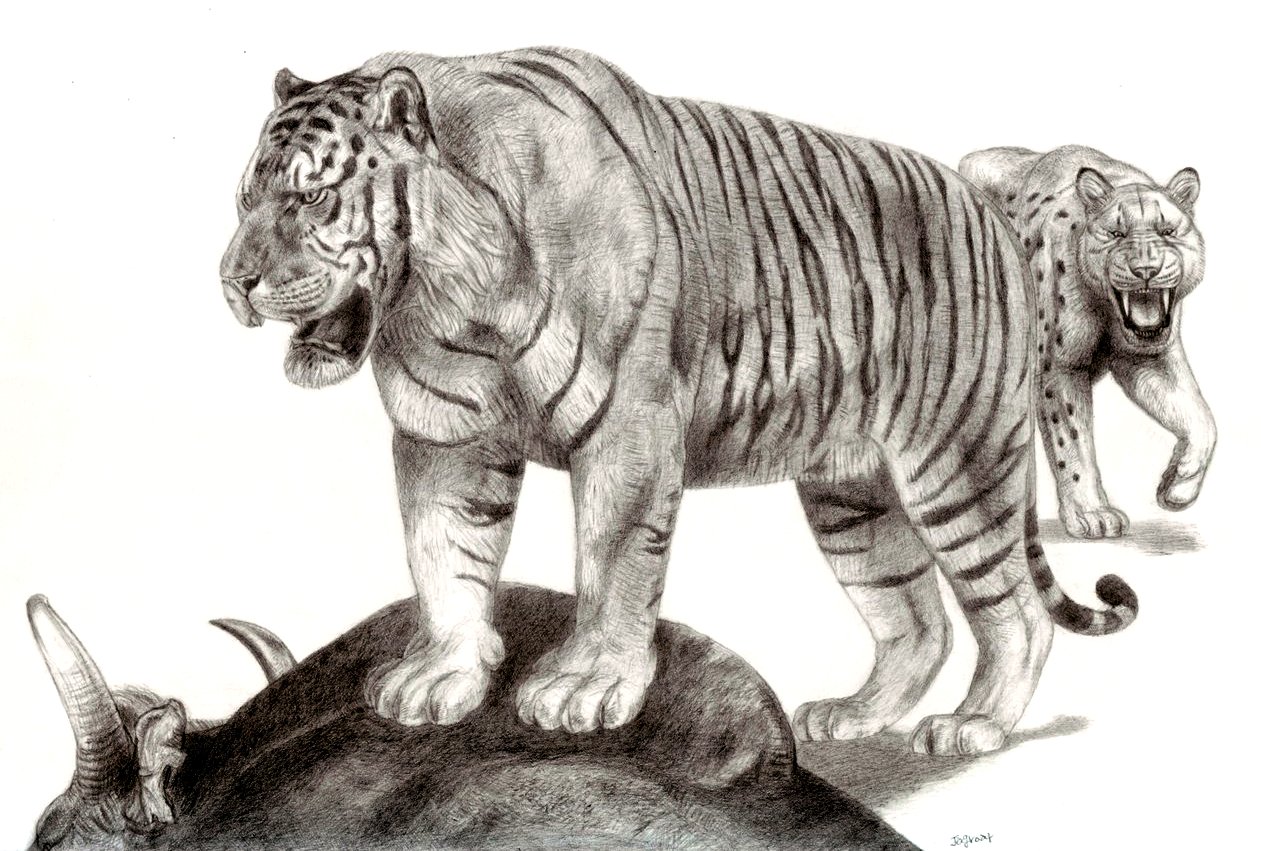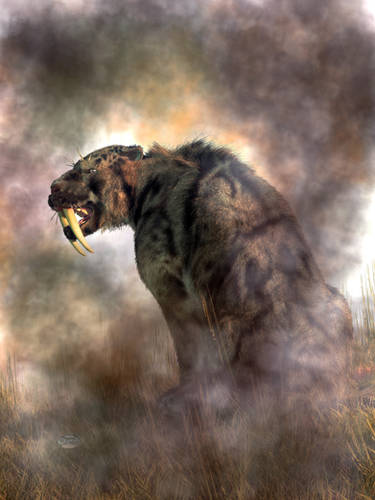ShopDreamUp AI ArtDreamUp
Deviation Actions
Description
A huge dominant ngandong tiger male is protecting his kill while the contemporary scimitar toothed cat(Homotherium ultimum) larks behind it.
I may color the image in the future, so I left it relatively lighter in values.
Please see the larger image.
This is my tribute to the species Panthera tigris, which is one of the most charismatic and the most severely endangered mega fauna on the planet.
We must help save these magnificent animals from extinction.
●Wanhsien(Wanxien) tiger(Panthera tigris acutidens, Hooijer 1947) was the pleistocene tiger subspecies which is considered to have originated in south of China and have been the ancestral form to majority of mainland modern tiger subspecies(may be excluding sunda subspecies).
Its habitat probably ranged up to the freezing inner mongolia to the north and some group might have looked very similar to the modern Amur variety(the woolly tiger).
Judging from scattered partial cranial and post cranial remains, its morphologies are very similar to those of modern mainland subspecies but certainly more massive and grander in scale(C. Groves).
●Ngandong tiger(Panthera tigris soloensis, Von Koenigswald 1933) is the great pleistocene tiger subspecies which inhabited sunda islands around 195000 years ago.
Some regard the tiger as the temporary invaders from mainland through the process of dynamic sea level changes and almost identical to Panthera tigris acutidens, while it's also considered to be ancestral to the modern javan tiger for tentative morphological similarities between the two(narrow nasal and occipital bones, relatively small metacarpals, high M1 index ...). Those theories seem to be contradictory.
Its femur bone was restored at around 480 mm in length and Dr. Hertler and Volmer(2007) gave the estimated weight of around 480 kg to a particularly large individual, using regression analysis based on the cranial.
Much older ancient tiger known as the trinil tiger(P.t.trinilensis) is also considered to have already colonized sunda islands more than a million years ago but the subspecies was most probably distinct enough from P.t.soloensis.
I basically present this prehistoric tiger as an intermediary between P.t.soloensis and P.t.acutidens, making its fur relatively thicker as can be seen in sumatran tigers and also as an adaptation to the pleistocene era. Stripes are thicker, more numerous and somewhat rosette-like in shape than can be seen in modern siberian tigers. Nasal is narrow and hind paws are relatively small for the size but canial and post cranial are overall, rendered to be very massive and robust.
Now I'll go back to images of elephants!
Jagroar
I may color the image in the future, so I left it relatively lighter in values.
Please see the larger image.
This is my tribute to the species Panthera tigris, which is one of the most charismatic and the most severely endangered mega fauna on the planet.
We must help save these magnificent animals from extinction.
●Wanhsien(Wanxien) tiger(Panthera tigris acutidens, Hooijer 1947) was the pleistocene tiger subspecies which is considered to have originated in south of China and have been the ancestral form to majority of mainland modern tiger subspecies(may be excluding sunda subspecies).
Its habitat probably ranged up to the freezing inner mongolia to the north and some group might have looked very similar to the modern Amur variety(the woolly tiger).
Judging from scattered partial cranial and post cranial remains, its morphologies are very similar to those of modern mainland subspecies but certainly more massive and grander in scale(C. Groves).
●Ngandong tiger(Panthera tigris soloensis, Von Koenigswald 1933) is the great pleistocene tiger subspecies which inhabited sunda islands around 195000 years ago.
Some regard the tiger as the temporary invaders from mainland through the process of dynamic sea level changes and almost identical to Panthera tigris acutidens, while it's also considered to be ancestral to the modern javan tiger for tentative morphological similarities between the two(narrow nasal and occipital bones, relatively small metacarpals, high M1 index ...). Those theories seem to be contradictory.
Its femur bone was restored at around 480 mm in length and Dr. Hertler and Volmer(2007) gave the estimated weight of around 480 kg to a particularly large individual, using regression analysis based on the cranial.
Much older ancient tiger known as the trinil tiger(P.t.trinilensis) is also considered to have already colonized sunda islands more than a million years ago but the subspecies was most probably distinct enough from P.t.soloensis.
I basically present this prehistoric tiger as an intermediary between P.t.soloensis and P.t.acutidens, making its fur relatively thicker as can be seen in sumatran tigers and also as an adaptation to the pleistocene era. Stripes are thicker, more numerous and somewhat rosette-like in shape than can be seen in modern siberian tigers. Nasal is narrow and hind paws are relatively small for the size but canial and post cranial are overall, rendered to be very massive and robust.
Now I'll go back to images of elephants!
Jagroar
Image size
1261x851px 233.44 KB
Make
Canon
Model
CanoScan LiDE 600F
© 2012 - 2024 Jagroar
Comments59
Join the community to add your comment. Already a deviant? Log In
The Pleistocene Siberian Tiger Would Be Called Ussuri Tiger, Who Is Larger.


































